How to Fix IT Band Pain from Running | Strengthening Exercises

One of the most dreaded injuries for any runner could easily be ITBS, the short name for iliotibial band syndrome (or IT band pain). Coming from personal experience, running with IT band pain isn’t fun.
I was deep in training for my very first marathon when I had my own run-in with IT band pain. Cruising down a trail path, my knee suddenly ached with pain but without any fall or misstep to explain the sudden onset. I had no idea it was my IT band causing this.
Cue weeks of painful running and a realization that I had been neglecting my strength and mobility work for the sake of building my mileage. I still managed to line up for and finish my marathon, but I lost valuable time and ego on race day when I repeatedly had to stop and walk due to pain.
How to Fix IT Band Pain (for Good)
Unfortunately, I’m not alone in knee pain from IT band syndrome. It’s one of the most common running injuries out there. But luckily, there are many steps we runners can take to avoid getting to that point in the first place. By adding some mobility and strength work to your training, you, too, can keep your IT band healthy and avoid being sidelined.
Let’s dig into exactly what ITB syndrome is and how to know if that’s what’s causing you pain. From there, we’ll show you some simple exercises to weave into your training to get you back on your feet and stay that way.
IT Band Pain from Running Explained
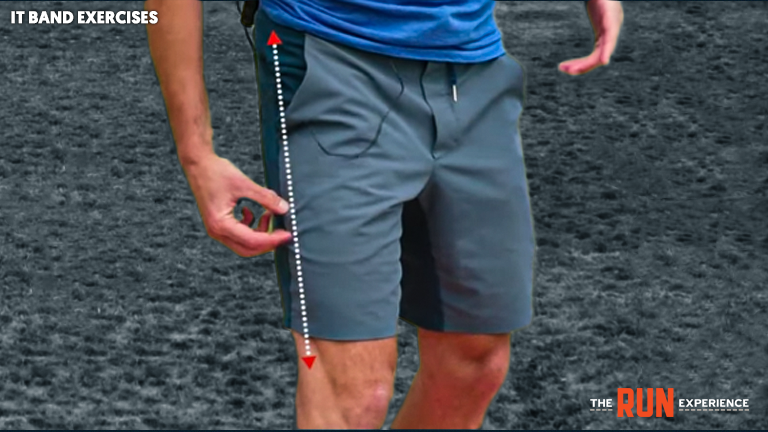
The IT band is a thick piece of connective tissue, called fascia, that runs from the pelvis to the knee on the outside of your leg. Think of it as a stiff rubber band. This band is responsible for movement toward and away from your body, such as your leg swinging back and forth as you run. It also helps stabilize your knee as you walk or run.
What Does Running With IT Band Syndrome Feel Like?
Imagine a stabbing or sharp pain on the side of your knee, and you’ve got a general idea of what an angry IT band feels like. Some people feel pain in their hip, but the majority of people complain of pain on the outside of the knee. The pain often intensifies when running downhill or doing around curves. Both of these movements put more impact force and torque on your leg and the IT band itself, which accounts for the worsening pain.
An IT band injury can be hard to identify in the beginning. It might feel like just a general soreness or tenderness in the hip or knee at the beginning of your run. The pain might even go away after you get through your warm-up mile, making you think there’s nothing really wrong. Unfortunately, that isn’t the case, and ignoring the pain will lead to a longer recovery time for your IT band.
Note that “runner’s knee” is different from IT band syndrome pain. Runner’s knee is usually felt in the front of the knee joint and is an overuse injury exacerbated by tight quads and a weak posterior chain. To learn more, check out this video all about knee pain:
If your knee pain is severe or if you’re feeling nerve-related pain such as sciatica, be sure to get to a doctor or physical therapist for a proper diagnosis.
What Causes IT Band Syndrome?
Weak hips and glutes are the biggest contributors to IT band syndrome. When these muscles are weak or underdeveloped your hips are more likely to drop from side to side as you run. Additionally, you’ll probably also have a little wobble in your knee with each step, which places stress on the IT band itself. The body relies on the strength and stability of your hips and glutes to lock your pelvis in place and prevent that shifting while running.
Repeat these shifty movement patterns for thousands of steps each run, and the IT band will eventually start to complain.
If you’ve ever had scuff marks on the inside of your calves after a run then chances are your hips are dropping at least a little when you run. This can be a warning sign to integrate strength training and glute workouts into your running routine asap. Get ahead of ITBS.
IT Band Strengthening Exercises To Keep You Healthy
A runner will likely hear to do IT band stretches to heal themselves, but those stretches don’t fix the issues that landed you with an IT band injury in the first place. Trying to stretch the IT band is like trying to stretch a belt. It might give a little, but as soon as you let go or release the stretch, it’ll go right back to its original position.
So instead, the purpose of the exercises we’re showing you is to strengthen the muscles surrounding the IT band. By fortifying your leg and hip strength you’ll put less pressure on your IT band and reduce the risk of pain or further injury to the area.
This is how to strengthen your IT band.
Foam rolling
While foam rolling won’t heal your pain it can be a gentle way to start rehabbing your injury. Rolling the IT band itself won’t do much good because it’s such a stiff tissue that doesn’t stretch in the typical sense. But, you can roll and massage the muscles surrounding the band, which can help provide a little slack in the system of your legs and provide some relief from the pain.
Use a foam roller to target each side of the IT band—the outside of the quads and hamstrings. Doing so will help restore blood flow to the area and encourage the tissues to glide smoothly alongside each other, rather than being stiff and tight.
Lacrosse or massage ball on TFL
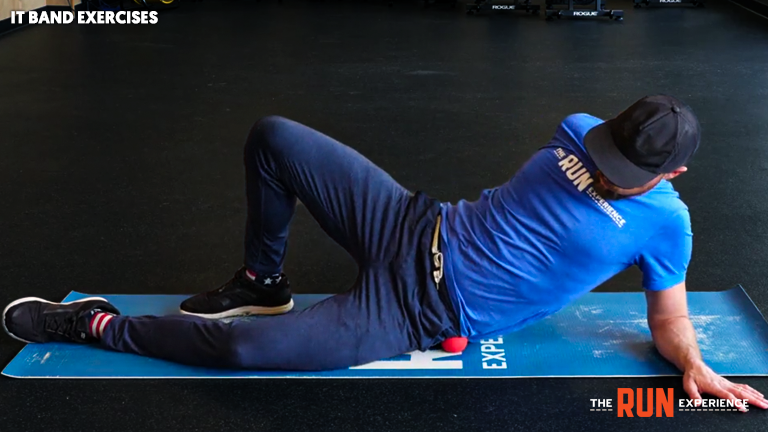
This one can be especially useful for those who feel ITB pain in their hip rather than their knee. On the side of the hip is a ball of muscle and tissue called the tensor fasciae latae, or TFL. It can get very tight and inhibit the internal and external rotation of your hip, as well as cause tension at the insertion point of the IT band into the pelvis.
Use a small to medium size ball such as a lacrosse ball, tennis ball, or yoga tune up ball on the outside of the hip where it connects to the leg. Spend at least two minutes on each hip, moving forward to the hip flexor and backward toward the gluteus medius to over the full range of the TFL. It’s easy to hold your breath as you find tender spots, so make sure to keep breathing throughout.
Clamshell
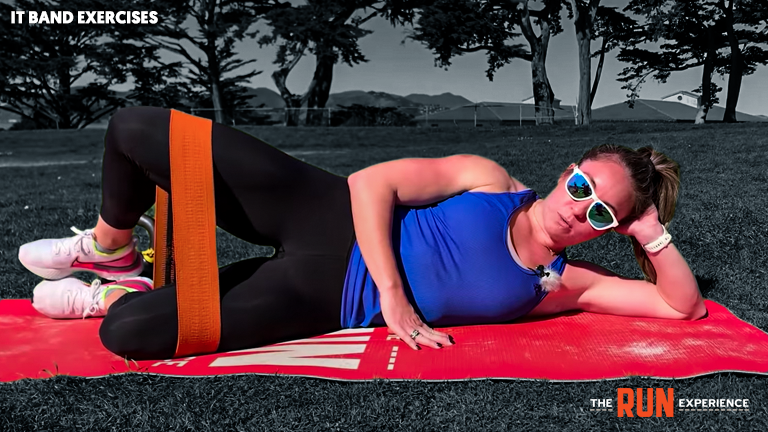
This is a great exercise for activating the glutes and IT band, and for strengthening the hip muscles. Lying on your side, bend your legs at a 45 degree angle to your body. With your heels together, raise your upper leg as far as you can while keeping your hips stacked. A common cheat for this movement is to allow the hips to roll backward to find greater range of motion. Avoid this to keep the focus where it should be, in your hips. You can add difficulty to the exercise by adding a resistance band around your knees.
Side-Lying Leg Raise
Similar to the clamshell, the leg raise works the outside of the hip and the glute medius, two contributors to hip stability when running.
Start by lying on your side, hips stacked and your legs extended so your whole body is in a straight line. Raise your upper leg to about 45 degrees (less if that’s more comfortable), being sure to not let your hips roll backward. You can slightly point your toe toward the ground to encourage your gluteus medius to activate strongly. Add difficulty to the exercise by adding a resistance band around your ankles or knees.
Hip Hike
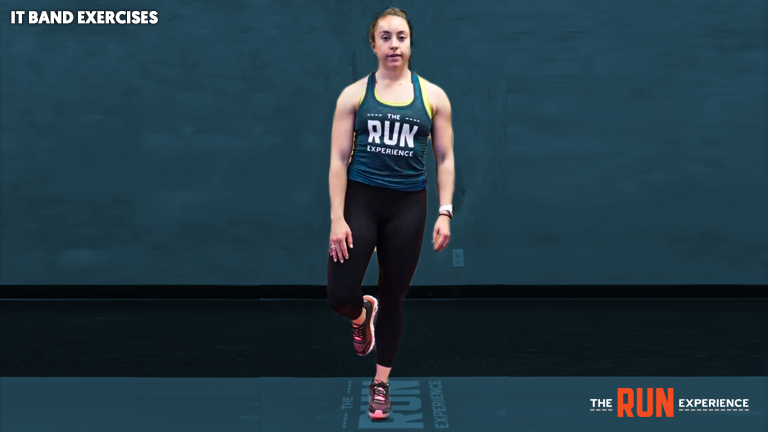
This exercise will help draw awareness to what it feels like when one hip is dropping as you run. By hiking the hip back up to level you’ll also squeeze in some extra activation work in the hip and core.
Stand on one leg and allow the hip of your lifted leg to drop down. Your knee will collapse toward your standing leg, just as it does on the run. Using the hip and glute strength of the standing leg, lift your dropped hip up until it’s level with the other hip. You probably won’t feel much in the lifted leg, but your standing glute will quickly feel the work.
Hip Bridge Or Hip Thrust
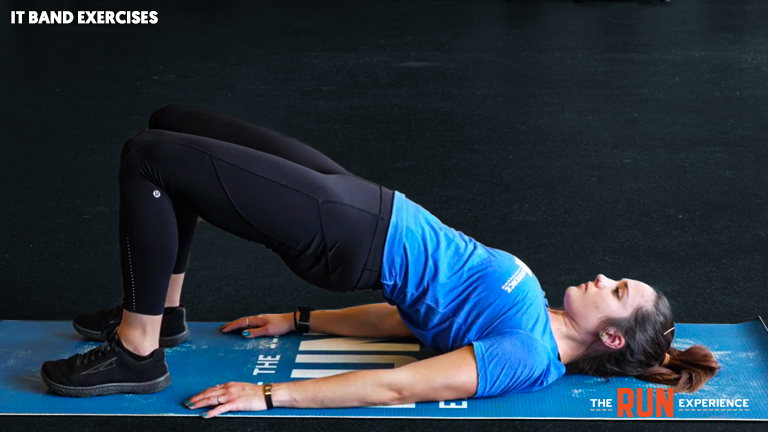
Two variations of a similar movement, just with different bases of support. With a bridge, your back will be on the ground whereas for the thrust it will be against a bench, couch, or box. The bridge provides a greater range of motion but the bridge is more accessible for beginners.
The key to both exercises is to use your glutes to lift your hips, not your lower back.
For the bridge, set up on the ground with your knees bent and feet flat on the ground. Your feet should be close to your hands to find the proper spacing from your feet to your butt. Using your glutes, lift your hips into the air, making sure to get a good glute squeeze at the top. If your hamstrings cramp during this exercise, imagine driving your knee forward as you lift, which will provide a little tension between your feet and back and can help keep the movement focused.
The starting position for the hip thrust will have you sitting against a bench or box so that the edge hits around the bottom of your shoulder blades. With your knees up and feet flat on the ground, raise your hips into the air, being very careful to not overextend your back as you come up. Pause for a glute squeeze at the top, then lower back to the starting position.
Single-Leg Deadlift
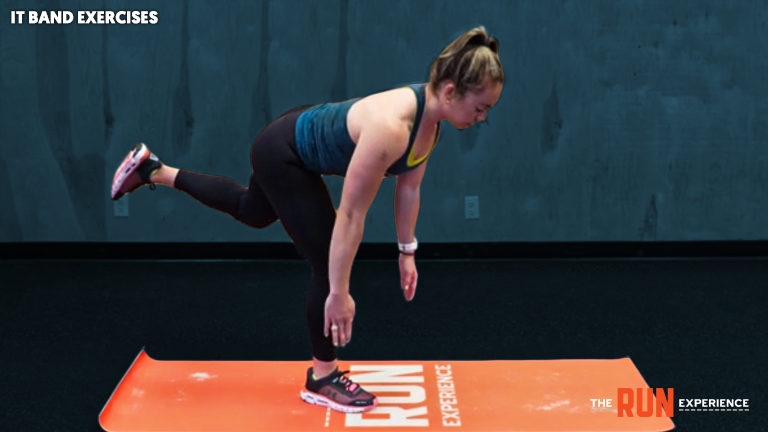
This final exercise is a very versatile movement that works your hip strength, balance, and coordination. You can make the movement easier by holding onto a wall for balance, or you can make it more challenging by holding a weight in one or both hands.
Start by balancing on one leg with a soft knee, bending the knee of the lifted leg slightly. Keeping your hips level, hinge forward at the hips and drop your upper body down toward the ground. If your hamstrings are very tight, bend your standing knee a little more. Keep a flat back as you lower down, and use the strength of your glutes and hamstrings to raise back up.
Frequently Asked Questions About IT Band
Can you run with IT band syndrome?
Yes, you can, but there are a few caveats. You shouldn’t run through extreme pain or discomfort, especially if it gets worse during and after your run.
However, you can run with IT band syndrome if your symptoms stay in check. If your pain doesn’t increase from running (and it’s going down week to week and month to month), you should be fine to run.
Watch your form and cadence to ensure you’re not compensating. On a pain scale, you should try to keep things consistently at a 3 out of 10 or below.
What are the best IT band stretches for runners?
We don’t recommend IT band stretches for runners. The IT band is a thick piece of connective tissue that’s nearly impossible to stretch. Instead, focus on stretching your other connected muscles and tissues and work on strengthening your IT band.
How do you strengthen your IT band?
You strengthen your IT band with consistent, well-planned IT band workouts. Don’t go crazy, though, and think that more is better. Do your IT band strengthening exercises, and then give your body time to heal, recover, and adapt—that’s where the strength gains will come.
How do you stop IT band pain?
You stop IT band pain by mitigating pain and inflammation while strengthening your IT band to withstand higher loads. Once it gains strength, you can handle more running volume.
Rehab With These IT Band Workouts And Get Back To Running Pain-Free
With a new understanding of IT band syndrome and a handful of targeted rehab movements in your pocket, you’re ready to take charge of your healing. Start slowly with the foam rolling and massage, then try the simpler movements like the hip hikes and clamshells as you get comfortable.
Time off from running alone won’t heal an IT band injury since you need to address the cause, as well. But it’s wise to dramatically reduce your mileage, if not completely stop running to focus on strength training.
Follow along with this workout focusing on hip stability to get even more ideas and options:
For even more about strengthening your glutes and hips, check out this article, How To Develop Strong Hips For Running: 8 Drills For Strength, Activation, and Mobility. And, don’t forget to download the mobile app for training with a supportive running community with members who have also worked their way through IT band injury and pain.
